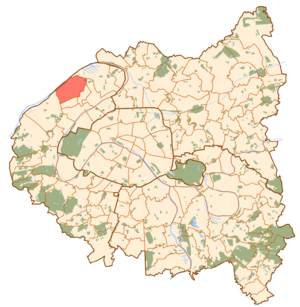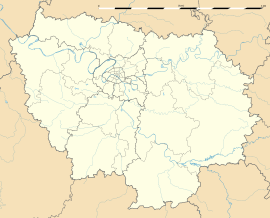Colombes facts for kids
Quick facts for kids
Colombes
|
||
|---|---|---|

The town hall of Colombes
|
||
|
||

Paris and inner ring départements
|
||
| Country | France | |
| Region | Île-de-France | |
| Department | Hauts-de-Seine | |
| Arrondissement | Nanterre | |
| Canton | Colombes-1 and 2 | |
| Intercommunality | Grand Paris | |
| Area
1
|
7.81 km2 (3.02 sq mi) | |
| Population
(2021)
|
88,870 | |
| • Density | 11,379/km2 (29,471/sq mi) | |
| Time zone | UTC+01:00 (CET) | |
| • Summer (DST) | UTC+02:00 (CEST) | |
| INSEE/Postal code |
92025 /92700
|
|
| Elevation | 23–44 m (75–144 ft) | |
| 1 French Land Register data, which excludes lakes, ponds, glaciers > 1 km2 (0.386 sq mi or 247 acres) and river estuaries. | ||
Colombes is a town located in the northwestern suburbs of Paris, France. It is about 10.6 kilometers (6.6 miles) away from the very center of Paris. In 2019, Colombes was known as the 53rd largest city in France.
Contents
What Does the Name Colombes Mean?
The name Colombes comes from the Latin word columna. This word means "column." People think the name might refer to a very old stone column. This column was used by a druidic cult long ago. It stood in Colombes until it was destroyed during the French Revolution. Another idea is that it refers to columns from a ruined Gallo-Roman villa that was also in Colombes.
A Brief History of Colombes
Colombes has changed its size over time. On March 13, 1896, about 17% of Colombes' land was separated. This part became a new town called Bois-Colombes. Bois-Colombes means "Colombes Woods." Later, on May 2, 1910, another 19% of Colombes' land was taken. This part became the town of La Garenne-Colombes. Because of these changes, Colombes is now only about two-thirds the size it was before 1896.
How Colombes' Population Has Grown
The number of people living in Colombes has changed a lot. Here's a look at how the population has grown over the years.
| Historical population | |||||||||||||||||||||||||||||||||||||||||||||||||||||||||||||||||||||||||||||||||||||||||||||||||||||||||||||||||||
|---|---|---|---|---|---|---|---|---|---|---|---|---|---|---|---|---|---|---|---|---|---|---|---|---|---|---|---|---|---|---|---|---|---|---|---|---|---|---|---|---|---|---|---|---|---|---|---|---|---|---|---|---|---|---|---|---|---|---|---|---|---|---|---|---|---|---|---|---|---|---|---|---|---|---|---|---|---|---|---|---|---|---|---|---|---|---|---|---|---|---|---|---|---|---|---|---|---|---|---|---|---|---|---|---|---|---|---|---|---|---|---|---|---|---|---|
|
|
||||||||||||||||||||||||||||||||||||||||||||||||||||||||||||||||||||||||||||||||||||||||||||||||||||||||||||||||||
| Source: EHESS and INSEE (1968-2017) | |||||||||||||||||||||||||||||||||||||||||||||||||||||||||||||||||||||||||||||||||||||||||||||||||||||||||||||||||||
What is the Climate Like in Colombes?
Colombes has an oceanic climate, which means it has mild temperatures and rainfall throughout the year. The average yearly temperature in Colombes is about 12.5 degrees Celsius (54.5 degrees Fahrenheit). The city gets about 623 millimeters (24.5 inches) of rain each year. May is usually the wettest month.
The warmest month is July, with an average temperature of about 20.6 degrees Celsius (69.1 degrees Fahrenheit). January is the coldest month, with an average of about 5.0 degrees Celsius (41.0 degrees Fahrenheit). The hottest temperature ever recorded in Colombes was 40.9 degrees Celsius (105.6 degrees Fahrenheit) on August 6, 2003. The coldest temperature ever recorded was -15.0 degrees Celsius (5.0 degrees Fahrenheit) on January 17, 1985.
| Climate data for Colombes (1981−2010 normals, extremes 1981−2018) | |||||||||||||
|---|---|---|---|---|---|---|---|---|---|---|---|---|---|
| Month | Jan | Feb | Mar | Apr | May | Jun | Jul | Aug | Sep | Oct | Nov | Dec | Year |
| Record high °C (°F) | 16.2 (61.2) |
21.0 (69.8) |
25.5 (77.9) |
31.1 (88.0) |
35.0 (95.0) |
37.9 (100.2) |
40.0 (104.0) |
40.9 (105.6) |
34.0 (93.2) |
30.9 (87.6) |
22.0 (71.6) |
17.5 (63.5) |
40.9 (105.6) |
| Mean daily maximum °C (°F) | 7.6 (45.7) |
8.8 (47.8) |
12.7 (54.9) |
16.2 (61.2) |
20.1 (68.2) |
23.2 (73.8) |
25.8 (78.4) |
25.5 (77.9) |
21.7 (71.1) |
16.8 (62.2) |
11.2 (52.2) |
7.9 (46.2) |
16.5 (61.7) |
| Daily mean °C (°F) | 5.0 (41.0) |
5.6 (42.1) |
8.7 (47.7) |
11.5 (52.7) |
15.3 (59.5) |
18.3 (64.9) |
20.6 (69.1) |
20.3 (68.5) |
17.0 (62.6) |
13.1 (55.6) |
8.3 (46.9) |
5.5 (41.9) |
12.5 (54.5) |
| Mean daily minimum °C (°F) | 2.4 (36.3) |
2.4 (36.3) |
4.7 (40.5) |
6.8 (44.2) |
10.5 (50.9) |
13.4 (56.1) |
15.4 (59.7) |
15.2 (59.4) |
12.2 (54.0) |
9.3 (48.7) |
5.5 (41.9) |
3.1 (37.6) |
8.4 (47.1) |
| Record low °C (°F) | −15.0 (5.0) |
−12.0 (10.4) |
−7.0 (19.4) |
−2.0 (28.4) |
1.9 (35.4) |
5.4 (41.7) |
9.0 (48.2) |
7.9 (46.2) |
4.7 (40.5) |
−2.2 (28.0) |
−6.7 (19.9) |
−9.1 (15.6) |
−15.0 (5.0) |
| Average precipitation mm (inches) | 49.6 (1.95) |
41.4 (1.63) |
46.9 (1.85) |
46.9 (1.85) |
63.7 (2.51) |
51.0 (2.01) |
58.3 (2.30) |
50.2 (1.98) |
48.0 (1.89) |
61.4 (2.42) |
48.1 (1.89) |
57.5 (2.26) |
623.0 (24.53) |
| Average precipitation days (≥ 1.0 mm) | 10.6 | 9.0 | 10.5 | 9.2 | 10.0 | 8.3 | 8.0 | 7.2 | 8.0 | 9.7 | 9.8 | 10.9 | 111.2 |
| Source: Météo-France | |||||||||||||
How Colombes is Governed
The city of Colombes is divided into two main areas for local government. These areas are called cantons:
- Colombes-1 (this is the northern part of the city)
- Colombes-2 (this is the southern part of the city)
Getting Around: Transport in Colombes
Colombes has several train stations that help people travel easily. These stations are part of the Transilien Paris – Saint-Lazare suburban rail line. The stations are:
- Colombes
- Le Stade
- La Garenne-Colombes
- Les Vallées
Learning in Colombes: Education
Colombes has many schools for young people. There are 21 preschools for the youngest children. For elementary school students, there are 19 schools.
For older students, Colombes has several secondary schools:
- Junior High Schools: Robert Paparemborde, Marguerite Duras, Gay Lussac, Moulin Joly, Jean-Baptiste Clément, Lakanal
- Senior High Schools: Lycée Guy de Maupassant, Lycee Polyvalent Claude Garamont, Lycee Polyvalent Anatole de France
Famous People from Colombes
Many interesting people have connections to Colombes. Here are a few:
- Quilapayún: A music group from Chile who lived in Colombes when they were in exile.
- Jordan Aboudou: A basketball player.
- Marie-Antoinette Katoto: A talented footballer.
- Eliaquim Mangala: Another well-known footballer.
- Steven Nzonzi: A footballer.
- Rama Yade: A politician who moved to Colombes with her family when she was young.
- pierpoljak: A reggae singer.
Sports in Colombes
Colombes is home to the Stade Olympique Yves-du-Manoir, a famous stadium. It was built in 1907. This stadium was very important for the 1924 Summer Olympics. It hosted the opening ceremony and many events. For the 1938 World Cup, the stadium was made bigger to hold 60,000 people.
Over time, the stadium became less important. In the 1990s, parts of it were taken down. Its capacity went down to 7,000. After some updates, it can now hold 14,000 people. The Racing 92 rugby club used to play there until 2017. Now, the RCF Paris football club plays at Yves-du-Manoir. The stadium will also be used for field hockey during the 2024 Summer Olympics.
Sister Cities
Colombes has special friendships with cities in other countries. These are called twin towns:
 Frankenthal, Germany (since 1958)
Frankenthal, Germany (since 1958) Legnano, Italy (since 1964)
Legnano, Italy (since 1964)
See also
 In Spanish: Colombes para niños
In Spanish: Colombes para niños




